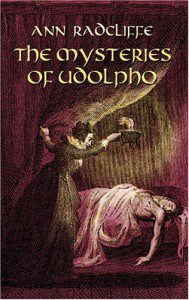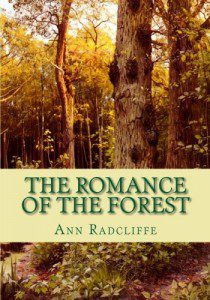 Of all the early Gothic writers, one woman in particular had a considerable impact on the genre. The ‘Great Enchantress’ of her age, Ann Radcliffe established many of the tropes of the Gothic, as well as providing literary weight to a genre that was regarded by many as mere sensationalist fiction. In fact, Sir Walter Scott praised her as “the first poetess of romantic fiction” and she was considered by her contemporaries to be as significant as Shakespeare and Milton. Her fiction was so popular that her fourth novel, The Mysteries of Uldolpho was hailed as the first ‘bestseller’ and she set the record for the highest paid novelist of the day. But what is it that Radcliffe established and if her work was so extraordinary why is she not more widely read today?
Of all the early Gothic writers, one woman in particular had a considerable impact on the genre. The ‘Great Enchantress’ of her age, Ann Radcliffe established many of the tropes of the Gothic, as well as providing literary weight to a genre that was regarded by many as mere sensationalist fiction. In fact, Sir Walter Scott praised her as “the first poetess of romantic fiction” and she was considered by her contemporaries to be as significant as Shakespeare and Milton. Her fiction was so popular that her fourth novel, The Mysteries of Uldolpho was hailed as the first ‘bestseller’ and she set the record for the highest paid novelist of the day. But what is it that Radcliffe established and if her work was so extraordinary why is she not more widely read today?
The Romance of the Forest is considered to be Radcliffe’s first success. Though not as well known now as her two later novels The Mysteries of Uldolpho and The Italian, in its day it was regarded as her best work. Set in France, it follows the journey of young Adeline who, abandoned by her father, is taken in by the La Motte family as they flee Paris. They find shelter in a ruined abbey described as being a foreboding sight, surrounded by a “romantic gloom” which instils in our heroine “a kind of pleasing dread” (a term often used to describe the very appeal of the Gothic). Abbeys and monasteries feature very heavily in Radcliffe’s work and indeed in much of the genre after. However these places that once offered religious sanctuary are often described in a state of decay, perhaps indicative of a kind of spiritual decline or erosion of moral boundaries so typical of the Gothic. The influence of the past upon the present is another Gothic theme, and Radcliffe’s other locations, often castles and ruins are an integral part of the architecture of the Gothic, prefiguring the more modern haunted house.
But these locations don’t serve solely as foreboding backdrops. They often function as prisons. Adeline, finding herself the object of the Marquis de Montalt’s desire, is continually held captive throughout the novel, initially within the Marquis’ château and later in the abbey that once served as her home. Interestingly, at the Marquis’ château Adeline is not detained with threats of violence but with enticements. The château is decorated lavishly, “designed to fascinate the imagination, and to seduce the heart”, a place described as “the palace of a fairy”. Looking out through the locked windows, Adeline declares, “Is this a charm to lure me to destruction?” Adeline resists temptation and waits to be rescued from the castle. In this she is the archetype of the Gothic heroine, the passive female, a damsel in distress, desired by every man she encounters and pursued and persecuted by the ones she spurns. Her vulnerability is also highly sexualised; she faints and is revived an inordinate amount in the text, she experiences frequent “palpitations of terror” and at one particularly tantalising moment, her gown is “thrown open at the bosom”. The reader is aligned with the male characters in these moments, complicit in her exposure and helplessness.
 But for all these instances of collapse, there are moments of rejuvenation. Adeline is replenished by natural landscapes and in these moments she temporarily steps out of the role of Gothic victim, becoming more assertive and independent. After escaping the Marquis she travels with another adoptive family, first to the South of France and then to Italy. Radcliffe typically uses foreign locations in her novels, partly due to the popularity of travel literature of the period but also to immerse the reader more fully in the unknown. On route toward the Glacier of Montanvert, Adeline declares that the surroundings “diffuse a sacred enthusiasm over the mind, and awaken sensations truly sublime” and later she describes the immensity of the spectacle “as if we were walking over the ruins of the world”. Radcliffe’s sublime landscapes tend to highlight the insignificance of man in contrast to the existence of a “Great Author” responsible for such impressive creations. Many later Gothic texts adopted a similar use of awe-inspiring landscapes as a way of examining man’s connection to the environment. In Mary Shelley’s Frankenstein for example, Victor Frankenstein retreats into nature, relishing the sense of alienation in the Alps, which he describes as “belonging to another earth” and later the Arctic becomes the battleground on which to face his monster in the ultimate fight between nature and science. In aligning with nature, he submits to a greater authority than his own when previously he has been so preoccupied with playing God.
But for all these instances of collapse, there are moments of rejuvenation. Adeline is replenished by natural landscapes and in these moments she temporarily steps out of the role of Gothic victim, becoming more assertive and independent. After escaping the Marquis she travels with another adoptive family, first to the South of France and then to Italy. Radcliffe typically uses foreign locations in her novels, partly due to the popularity of travel literature of the period but also to immerse the reader more fully in the unknown. On route toward the Glacier of Montanvert, Adeline declares that the surroundings “diffuse a sacred enthusiasm over the mind, and awaken sensations truly sublime” and later she describes the immensity of the spectacle “as if we were walking over the ruins of the world”. Radcliffe’s sublime landscapes tend to highlight the insignificance of man in contrast to the existence of a “Great Author” responsible for such impressive creations. Many later Gothic texts adopted a similar use of awe-inspiring landscapes as a way of examining man’s connection to the environment. In Mary Shelley’s Frankenstein for example, Victor Frankenstein retreats into nature, relishing the sense of alienation in the Alps, which he describes as “belonging to another earth” and later the Arctic becomes the battleground on which to face his monster in the ultimate fight between nature and science. In aligning with nature, he submits to a greater authority than his own when previously he has been so preoccupied with playing God.
Along with the significance of setting, Radcliffe established many of the narrative devices typical of the Gothic. When a resident at the abbey, Adeline is beset by nightmares (another Gothic convention). She dreams of some dark, concealed rooms, (secrets are another Gothic feature) decorated as if for a funeral. Inside she finds a coffin and inside that, a corpse which bleeds profusely “until the whole chamber was overflowed”. The imagery of a blood used here, apart from being replicated in countless horror films, could mark Adeline’s transgression into this forbidden space, implying that all discoveries are made at a cost. Later, Adeline actually finds these concealed apartments in the abbey, hidden behind the arras in her bedroom and discovers not a coffin but a partially illegible manuscript written by a young man once held captive in the abbey. Adeline is strangely thrilled by reading about his suffering (as the reader is, by reading about hers).
So, sinister settings, the sublime, forbidden spaces, portentous dreams and the eroticised victim – all are part of Radcliffe’s legacy. Since then her work has been imitated to an unprecedented degree. Some writers of the period openly mimicked her work, changing only the gender of Radcliffe’s characters while telling the very same story, whereas others borrowed Radcliffe’s cast and gave them new narratives. But beyond the immediate derivations and adaptations, a lot of what Radcliffe established two hundred years ago has had a lasting influence on the genre. New readers to Radcliffe might find the plot devices a little too familiar and some of her ideas a bit too clichéd – this may partly explain her decline in popularity – but what we need to remember is that Radcliffe was the creator of these tropes. It seems unfortunate that Radcliffe isn’t more widely read today but arguably, she is, haunting the fabric of so many other Gothic works, as the “Great Author” of it all.
V.H. LESLIE
If you enjoyed V.H. Leslie’s column, please consider clicking through to our Amazon Affiliate links and buying some of her fiction. If you do you’ll help keep the This Is Horror ship afloat with some very welcome remuneration.









